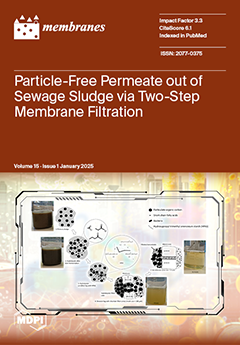Short-chain fatty acids (SCFAs) are valuable metabolic intermediates that are produced during dark fermentation of sludge, which, when capitalized on, can be used as chemical precursors for biotechnological applications. However, high concentrations of solids with SCFAs in hydrolyzed sludge can be highly detrimental
[...] Read more.
Short-chain fatty acids (SCFAs) are valuable metabolic intermediates that are produced during dark fermentation of sludge, which, when capitalized on, can be used as chemical precursors for biotechnological applications. However, high concentrations of solids with SCFAs in hydrolyzed sludge can be highly detrimental to downstream recovery processes. This pilot-scale study addresses this limitation and explores the recovery of SCFAs from primary sludge into a particle-free permeate through a combination of chamber filter-press (material: polyester; mesh size: 100 µm) and cross-flow microfiltration (material: α-Al
2O
3; pore size: 0.2 µm; cross-flow velocity: 3 m∙s
−1; pressure = 2.2 bars). Firstly, primary sludge underwent dark fermentation yielding a hydrolyzate with a significant concentration of SCFAs along with total solids (TS) concentration in the range of 20 to 30 g∙L
−1. The hydrolyzate was conditioned with hydroxypropyl trimethyl ammonium starch (HPAS), and then dewatered using a filter press, reducing TS by at least 60%, resulting in a filtrate with a suspended solids concentration ranging from 100 to 1300 mg∙L
−1. Despite the lower suspended solids concentration, the microfiltration membrane underwent severe fouling due to HPAS’s electrostatic interaction. Two methods were optimized for microfiltration: (1) increased backwashing frequency to sustain a permeate flux of 20 L∙m
−2∙h
−1 (LMH), and (2) surface charge modification to maintain the flux between 70 and 80 LMH. With backwashing, microfiltration can filter around 900 L∙m
eff−2 (without chemical cleaning), with the flux between 50 and 60 LMH under semi-continuous operation. Evaluating the particle-free permeate obtained from the treatment chain, around 4 gC
SCFAs∙capita
−1∙d
−1 can be recovered from primary sludge with a purity of 0.85 to 0.97 C
SCFAs∙DOC
−1.
Full article






